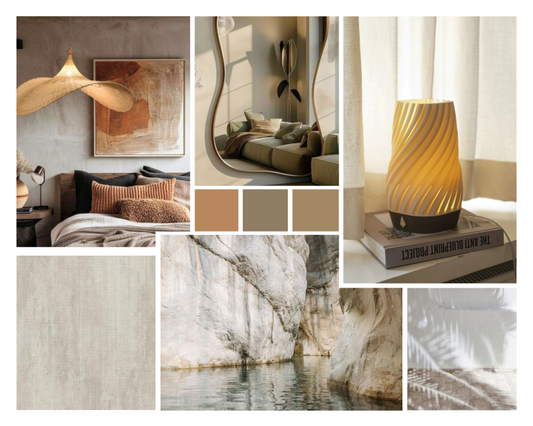Creating a Moodboard
A strong interior design starts with a clear understanding of your personal style and preferences. A moodboard helps you define your direction and ensures your interior feels cohesive. In this blog, we’ll explain what a moodboard is, how to create one, and how to translate it into a more specific furniture moodboard.
What Is a Moodboard?
A moodboard is a visual tool where you gather colors, materials, shapes, and atmospheres that appeal to you. It helps you clarify your aesthetic and makes it easier to support your design choices or communicate your vision with an interior professional.
-

A moodboard created by AB Interiors
How to Create a Moodboard
- Gather inspiration
Think of interior photos, images from nature, color palettes, materials, and objects you’re drawn to. Use Pinterest, magazines, or real material samples.
- Define a color palette
Choose a base of two to three neutral tones and add one or two accent colors. These will guide your future design decisions.
- Select textures and materials
Consider wood types, textiles, metals, or ceramics. These bring depth and tangibility to your moodboard.
- Create structure
Arrange your visuals and samples in a way that clearly communicates the mood and style you’re aiming for.
- Work digitally or physically
A digital moodboard is easy to share and adjust. A physical one, with real materials, often gives a more realistic sense of how elements interact.
-

A furniture moodboard created by AB Interiors
What Is a Furniture Moodboard?
A furniture moodboard is a more specific version of your overall moodboard. It focuses on combining furniture pieces and accessories that reflect your chosen style and atmosphere.
Here’s how to make one:
- Start with the key pieces
Choose your main furniture like the sofa, dining table, or storage cabinet—these set the tone for the space.
- Add supporting elements
Include chairs, side tables, lighting, textiles, and décor. Ensure they align with both your style and each other.
- Pay attention to shapes and proportions
Consider how curved forms versus clean lines work together. Balance is key.
- Add context images
Use interior shots that show the furniture in a real setting. This helps you visualize how the whole space might come together.
Why This Helps
Moodboards bring clarity and consistency to your design process. They help avoid impulse buys and ensure each choice contributes to a coherent whole. A furniture moodboard takes this a step further, guiding your actual purchasing and layout decisions.
More tips?
View all-

Een eye-catcher in je interieur
A striking pendant lamp instantly elevates your living room to the next level. With the right colors, materials and placement, such a lamp becomes not just a light source but...
Een eye-catcher in je interieur
A striking pendant lamp instantly elevates your living room to the next level. With the right colors, materials and placement, such a lamp becomes not just a light source but...
-

Sustainable Lighting: Recycled and Biobased
In this series, we invite you to take a behind-the-scenes look at Noord See Lights. We'll show you how our lamps are crafted and the materials we use. Sustainability and...
Sustainable Lighting: Recycled and Biobased
In this series, we invite you to take a behind-the-scenes look at Noord See Lights. We'll show you how our lamps are crafted and the materials we use. Sustainability and...
-

Creating a Moodboard
A strong interior design starts with a clear understanding of your personal style and preferences. A moodboard helps you define your direction and ensures your interior feels cohesive. In this...
Creating a Moodboard
A strong interior design starts with a clear understanding of your personal style and preferences. A moodboard helps you define your direction and ensures your interior feels cohesive. In this...





